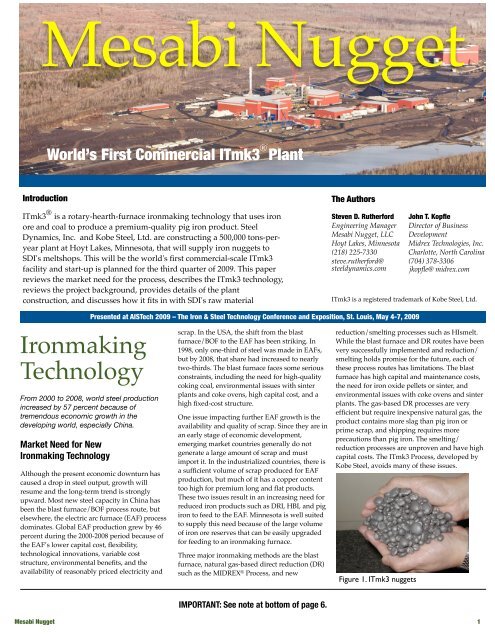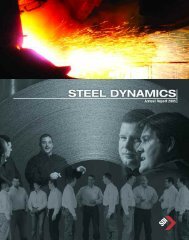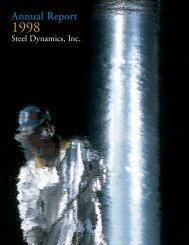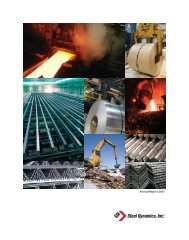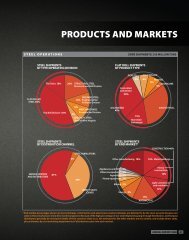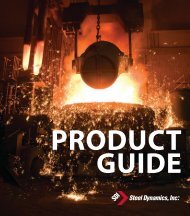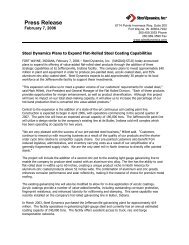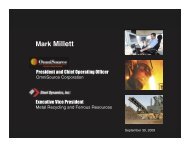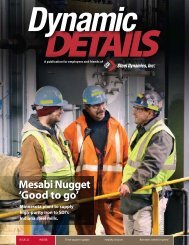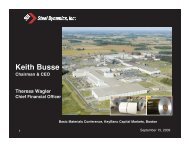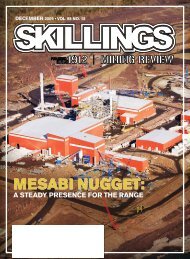Ironmaking Technology - Steel Dynamics, Inc.
Ironmaking Technology - Steel Dynamics, Inc.
Ironmaking Technology - Steel Dynamics, Inc.
Create successful ePaper yourself
Turn your PDF publications into a flip-book with our unique Google optimized e-Paper software.
MesabiI R O N MNuggetA K I N G®World’s First Commercial ITmk3 PlantIntroduction®ITmk3 is a rotary-hearth-furnace ironmaking technology that uses ironore and coal to produce a premium-quality pig iron product. <strong>Steel</strong><strong>Dynamics</strong>, <strong>Inc</strong>. and Kobe <strong>Steel</strong>, Ltd. are constructing a 500,000 tons-peryearplant at Hoyt Lakes, Minnesota, that will supply iron nuggets toSDI's meltshops. This will be the world's first commercial-scale ITmk3facility and start-up is planned for the third quarter of 2009. This paperreviews the market need for the process, describes the ITmk3 technology,reviews the project background, provides details of the plantconstruction, and discusses how it fits in with SDI's raw materialThe AuthorsSteven D. RutherfordEngineering ManagerMesabi Nugget, LLCHoyt Lakes, Minnesota(218) 225-7330steve.rutherford@steeldynamics.comJohn T. KopfleDirector of BusinessDevelopmentMidrex Technologies, <strong>Inc</strong>.Charlotte, North Carolina(704) 378-3306jkopfle@ midrex.comITmk3 is a registered trademark of Kobe <strong>Steel</strong>, Ltd.<strong>Ironmaking</strong><strong>Technology</strong>From 2000 to 2008, world steel productionincreased by 57 percent because oftremendous economic growth in thedeveloping world, especially China.Market Need for New<strong>Ironmaking</strong> <strong>Technology</strong>Presented at AISTech 2009 – The Iron & <strong>Steel</strong> <strong>Technology</strong> Conference and Exposition, St. Louis, May 4-7, 2009Although the present economic downturn hascaused a drop in steel output, growth willresume and the long-term trend is stronglyupward. Most new steel capacity in China hasbeen the blast furnace/BOF process route, butelsewhere, the electric arc furnace (EAF) processdominates. Global EAF production grew by 46percent during the 2000-2008 period because ofthe EAF’s lower capital cost, flexibility,technological innovations, variable coststructure, environmental benefits, and theavailability of reasonably priced electricity andscrap. In the USA, the shift from the blastfurnace/BOF to the EAF has been striking. In1998, only one-third of steel was made in EAFs,but by 2008, that share had increased to nearlytwo-thirds. The blast furnace faces some seriousconstraints, including the need for high-qualitycoking coal, environmental issues with sinterplants and coke ovens, high capital cost, and ahigh fixed-cost structure.One issue impacting further EAF growth is theavailability and quality of scrap. Since they are inan early stage of economic development,emerging market countries generally do notgenerate a large amount of scrap and mustimport it. In the industrialized countries, there isa sufficient volume of scrap produced for EAFproduction, but much of it has a copper contenttoo high for premium long and flat products.These two issues result in an increasing need forreduced iron products such as DRI, HBI, and pigiron to feed to the EAF. Minnesota is well suitedto supply this need because of the large volumeof iron ore reserves that can be easily upgradedfor feeding to an ironmaking furnace.Three major ironmaking methods are the blastfurnace, natural gas-based direct reduction (DR)such as the MIDREX ® Process, and newreduction/smelting processes such as HIsmelt.While the blast furnace and DR routes have beenvery successfully implemented and reduction/smelting holds promise for the future, each ofthese process routes has limitations. The blastfurnace has high capital and maintenance costs,the need for iron oxide pellets or sinter, andenvironmental issues with coke ovens and sinterplants. The gas-based DR processes are veryefficient but require inexpensive natural gas, theproduct contains more slag than pig iron orprime scrap, and shipping requires moreprecautions than pig iron. The smelting/reduction processes are unproven and have highcapital costs. The ITmk3 Process, developed byKobe <strong>Steel</strong>, avoids many of these issues.Figure 1. ITmk3 nuggetsIMPORTANT: See note at bottom of page 6.Mesabi Nugget! 1
I R O N M A K I N G<strong>Steel</strong> <strong>Dynamics</strong> and Kobe <strong>Steel</strong> build Mesabi NuggetBased on the success of the PDP, the partnersbegan planning for a commercial-scalefacility. On November 20, 2007, <strong>Steel</strong><strong>Dynamics</strong> (SDI) and Kobe <strong>Steel</strong> signed theagreements to proceed with a 500,000 tpylarge scale demonstration plant (LSDP) to bebuilt near Hoyt Lakes, Minnesota, on the siteof the old LTV Mining facility.The plant would be known as Mesabi Nuggetin recognition of its location on the MesabiIron Range, as shown in Figure 7.For initial operations, ore will be purchasedfrom Cliffs’ Northshore Mine and othersources. A mining operation is beingdeveloped and permitted and it is expected tocommence operation in late 2011 to supplyiron ore concentrate for the ITmk3 plant. Coalwill be purchased from U.S. suppliers.Figure 7. Mesabi Nugget site at Hoyt Lakes in northeastern MinnesotaFigure 6. Mesabi Nuggetsproduced at pilot plant in 2003.Figure 8. Aerial view of Mesabi Nugget LSDP site.Mesabi Nugget plantand mining siteFigure 8 is an aerial view ofthe LSDP site. Because of thesevere winter weather conditionsin the area (temperaturesdown to -40º F), theprocessing facilities areenclosed in buildings.Area 1PitThe RHF is housed in aseparate building from thefeed material processing andpelletizing equipment.2 West XThe body of water labeledArea 1 Pit is an 830- acremined-out taconite pit thatwill be used as the freshwaterintake for the plant.The lake in the photo labeled2 West X is one of severalfuture mining sites.4! Mesabi Nugget
I R O N M A K I N GConstruction of the Mesabi NuggetLarge-Scale Demonstration PlantFigures 9 through 12 show constructionprogress at the site. RHF foundation sitepreparation was begun in May 2007. In Junethe order was placed for the rotary hearthfurnace and full-scale site preparationactivities began. Figures 9 and 10 show theArea 1 Pit and behind it in Figure 10 is thelocation of one of the future mine sites.The RHF foundation was completed in thefirst quarter of 2008 and the buildings werecompleted in late 2008. In Figure 11, theramp from the left going into the center ofthe RHF is for maintenance equipment.The structures at the near side of thefoundation are for product discharge.Following water cooling, a magnetic systemwill be used to separate nuggets from slagand the nuggets will be loaded into rail carsfor transport to SDI.Figure 9. Grading of plant siteadjacent to large Area 1 pit(2007)In Figure 12, the RHF building is to the leftwith the nugget cooler in front and thematerial preparation building is to the right.Future ExpansionThe site has been set up to provide for ease ofexpansion. Phase II of the project will includemining of taconite, crushing andconcentrating, and up to two additionalITmk3 Plants. The mine contains 160 milliontons of proven ore reserves. The miningoperations will produce concentrate for thenugget plants, and possibly sell someproduct to other users.Figure 10. Pouring rotary hearthfurnace foundationsThe projects are providing many benefits forthe area. The capital cost of the first ITmk3Plant is about $260 million and the minedevelopment about $165 million. Theprojects will generate significantemployment on the iron range, including1,500 construction workers, 100 permanentjobs for operation of the LSDP, another 250positions for operation of the Phase II units,and 200 support services jobs.The commercialization of ITmk3 will providethe iron range with the world’s first largescale plant for this breakthrough environmentallyfriendly technology. It will utilizedomestic iron ore and coal and reduce U.S.dependence on foreign sources of pig iron.Figure 11. Completed rotary hearth furnace foundations (2008)Mesabi Nugget! 5
I R O N M A K I N GFigure 12. Mesabi Nugget rotary hearth furnace building (left) and material preparation building (right), late 2008.Strategic BenefitsThe LSDP provides numerous strategicbenefits for SDI and Kobe. <strong>Steel</strong> <strong>Dynamics</strong>operates five EAF mini-mills producingstructural steel, rebar, SBQ products, and flatrolledproducts, with total capacity of 6.5million tpy of finished products. Thisrequires the use of over 7 million tpy offeedstock, a combination of ferrous scrap,market pig iron, and high value liquid pigiron provided from the company’s Iron<strong>Dynamics</strong> operation in Butler, Indiana. In2008, Iron <strong>Dynamics</strong> supplied 176,000 tons ofSDI’s pig iron requirements and theremaining 174,000 tons were purchased onthe open market.The open market pig iron is purchased fromBrazil, Russia, and Ukraine, putting SDI atrisk when the market is tight or prices arehigh. In 2008, the price of pig iron reachedover $1,000/ton.SDI’s objective is to control the supply ofmore of its charge materials. One step was topurchase OmniSource, one of the largestprocessors and distributors of scrap andsecondary metals in North America.The LSDP is another step and will provideSDI’s minimills a domestic source of highgrade pig iron.Kobe <strong>Steel</strong> is Japan’s fourth largeststeelmaker, with an annual capacity of about8 million tpy. It also has a large engineeringgroup that designs and builds facilities foriron and steelmaking, infrastructure,environmental treatment, and otherapplications.Kobe’s Iron Unit Group works closely withMidrex Technologies to supply MIDREX ®Direct Reduction Plants and FASTMETPlants worldwide.To date, there have been 69 MIDREX Plantsbuilt or under construction in 21 countries,with a total annual capacity of 50 milliontons. In addition, KSL has supplied orcontracted five FASTMET Plants in Japanwith a total feed capacity of 0.8 million tpy.The FASTMET facilities recycle iron-bearingby-products from Japanese integrated steelmills.Kobe and Midrex see the potential of theITmk3 Process and are actively pursuingprojects worldwide. The LSDP is an idealproject to demonstrate the technology atscale and pave the way for future contracts.Midrex is a partner for engineering,equipment supply, and field services andboth companies will gain valuable experiencein the design and startup of the plant.ConclusionsThe Mesabi Nugget ITmk3 Project willprovide an environmentally responsible andsafe facility on the Minnesota Iron Range.The plant will make history as the first toconvert taconite to a value added reducediron product on the range and the world’sfirst commercial scale ITmk3 Plant. Thenuggets will provide <strong>Steel</strong> <strong>Dynamics</strong> avaluable source of high quality electric arcfurnace feedstock. The project promisesstrategic benefits for SDI as a means tocontrol a portion of its raw material supply.For Kobe <strong>Steel</strong>, successful start-up andoperation will pave the way for future plantsales, nugget sales, and technologylicensing.REFERENCES1. J.M. McClelland, “A Layman’s Guide tothe Midrex and Kobe <strong>Steel</strong> RotaryHearth Furnace Technologies,” Directfrom Midrex From the Hearth, Winter2007/2008, pp. 4-7.2. H. Tanaka, K. Miyagawa, and T.Harada, ”FASTMET ® , FASTMELT ® , andITmk3: Development of New Coalbased<strong>Ironmaking</strong> Processes,” Directfrom Midrex From the Hearth, Winter2007/2008, pp. 8-13.IMPORTANT: After this paper was presented in May 2009, the project’s timeline and cost estimates changed. Completion of the project andthe start of commissioning were delayed until late 4th quarter 2009. The cost of the project is expected to be higher than estimated in May.All predictive statements about the completion and performance of the operation are intended to be made as “forward-looking” within thesafe-harbor protections of the Private Securities Litigation Reform Act of 1995. Refer to SDI’s 10-K and other SEC filings. 12/30/20096! Mesabi Nugget


